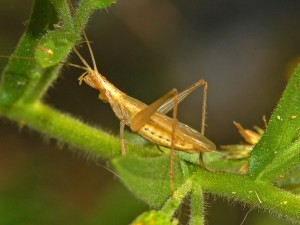Traffic poses a direct threat to the survival of insects; they can easily be squashed under a tire or on a windshield. However, it also may pose an indirect threat by causing noise that interferes with mating calls.
Traffic and other anthropogenic sounds create noise pollution, which affects communication between animals in various ways. It could disrupt a call, altering the signal before it is received, possibly triggering a different behavioral response. Additionally, noise can mask the song by being louder or of a similar frequency. If traffic is louder than an animal’s call, the auditory system of other animals will only detect the the louder noise, as the quieter call will be hidden underneath. It is as if you were at a concert, trying to talk to a friend—the music blasting from the speakers overwhelms your voice even if you’re screaming. Your voice, or a mating call, is masked further if the surrounding noise is of a similar frequency to your speech, as that forces them to compete for the attention of your ear, where the louder one will win. If the sounds are of different frequencies, they are heard by different receptors so there is less competition.
Since a good mating call is often the first step towards reproduction, many animals counteract these effects by altering their calls to avoid masking, either by increasing the amplitude or changing the frequency of their signal. In a recently released study, Orci and colleagues examined whether male tree crickets (Oecanthus pellucens) modify their mating song in response to varying levels of traffic. Orci et al. chose to study the O. pellucens because insects play a vital role in natural and urban ecosystems, and these crickets both use acoustic signals to attract females and are common in urban areas. Additionally, their song is of a relatively low frequency, so it is more susceptible to being masked by the low frequencies of traffic. To test their question, Orci et al. conducted two studies: one in the field and one in the lab, where they recorded cricket songs during quiet and while hearing traffic noise (real or artificial).
Orci et al. analyzed four components of the songs: duration, signal repetition, pauses, and the fundamental frequency. Because crickets produce sound using their wings, they have the ability to alter the frequency of their calls by shifting their wing position. Despite this, Orci et al. found no evidence of crickets altering the frequency of their song to allow it to be heard over traffic. They also found there was no significant effect on signal repetition, and there was only a significant increase in number of pauses when outdoors. However, both the indoor and outdoor studies suggest cricket signals during traffic were significantly shorter than during silence. These results imply that the crickets do not modify their calls to be received over traffic. Instead, when they sense noise and realize their own songs are unlikely to be heard, they reduce the energy put towards mating calls by shortening the song and perhaps inserting more pauses.
This is potentially significant for the reproduction of these males. In many insects, including a different Oecanthus species, females have been documented as preferring longer signals. The males who live near roads thus may be less likely to find mates compared to those who do not have to time their calls around traffic. There is a tradeoff between the length of the song (better chance of mating) and the energetic cost of a longer signal. In traffic, it seems that the energetic costs outweigh the mating benefits. These results imply that anthropogenic noise and increased urbanization are affecting mating patterns of other animals, even without direct contact, which raises the question: how many more organisms are we affecting in this way that we have yet to notice?
Nevertheless, this study did support one additional point: traffic is terrible for everyone, even insects.
Reference:
Orci, K.M, Petroczki, K, & Barta, Z. (2016). Instantaneous song modification in response to fluctuating traffic noise in the tree cricket Oecanthus pellucens. Animal Behavior, 112, 187-194.


I wanted to know if females become choosier near the highways when males go silent?